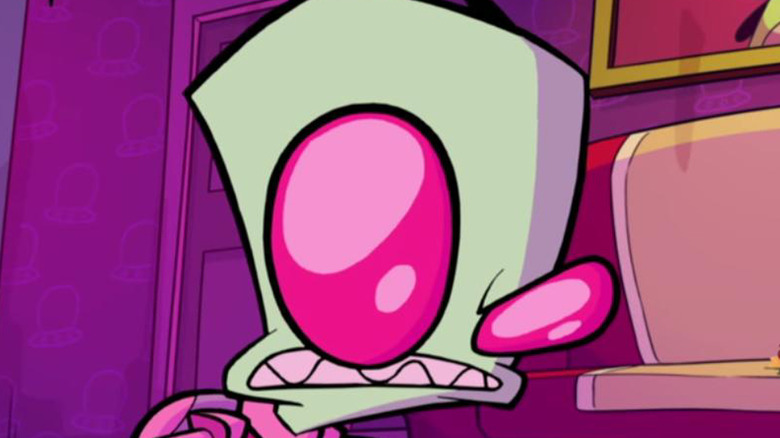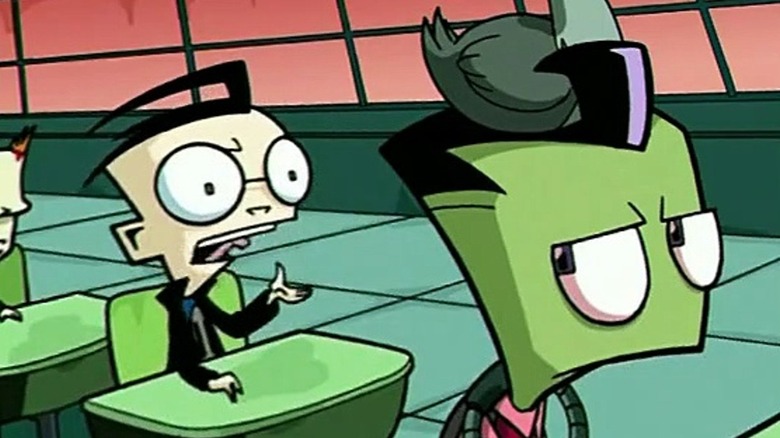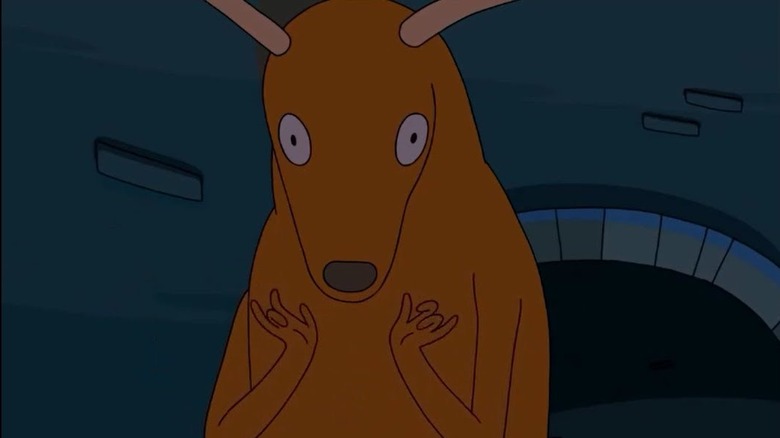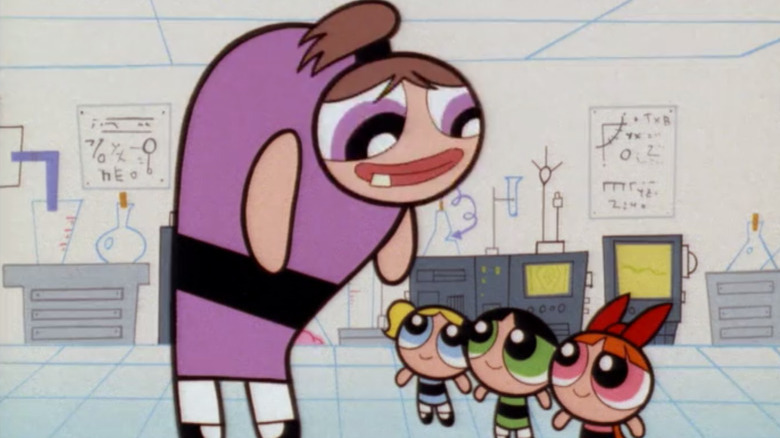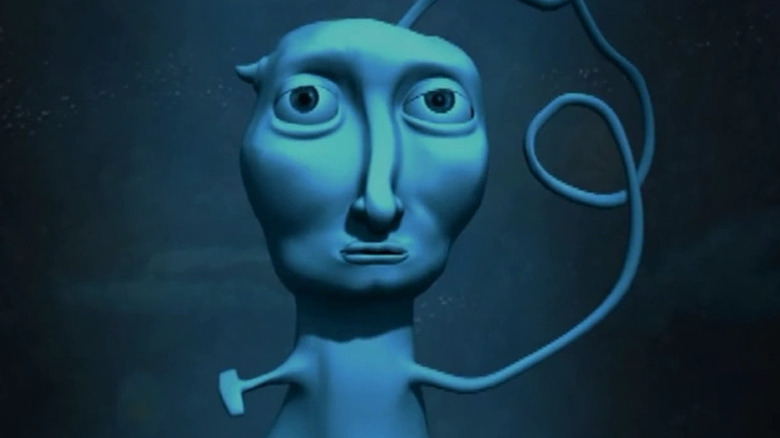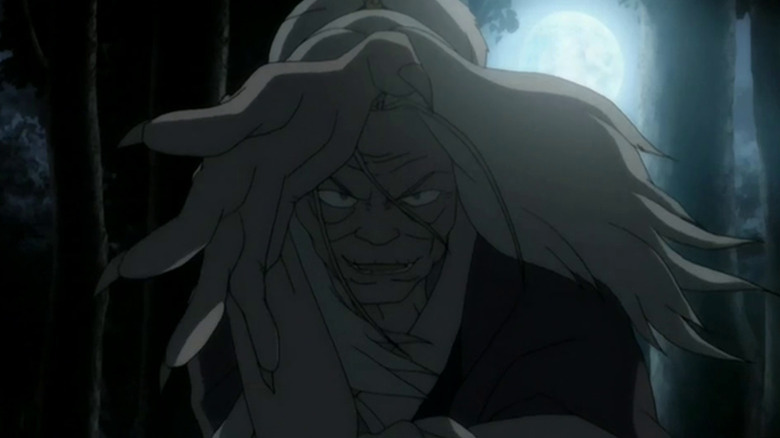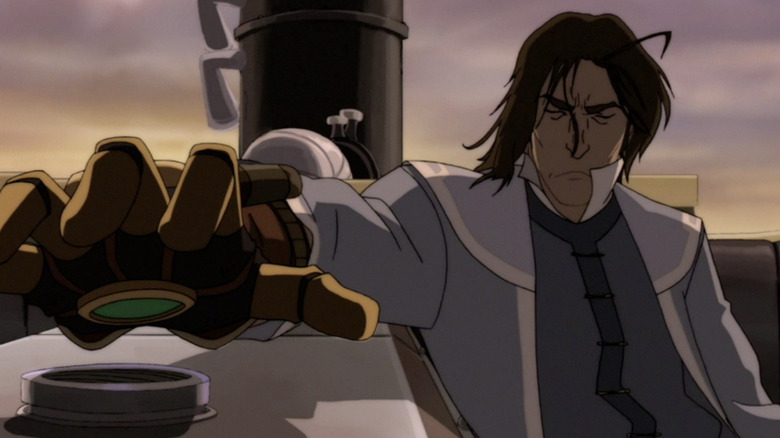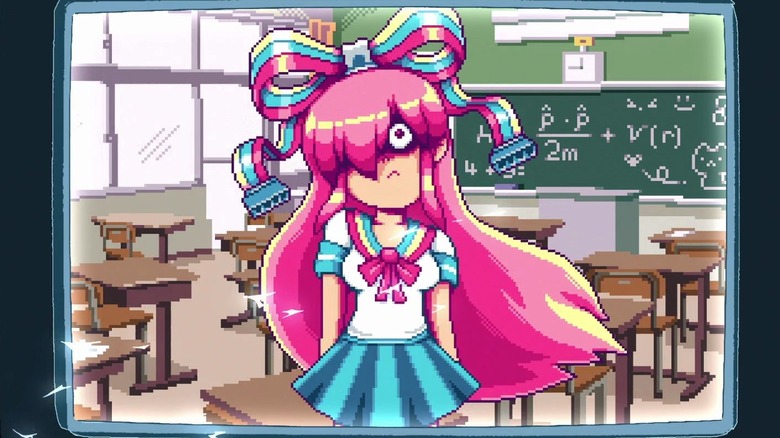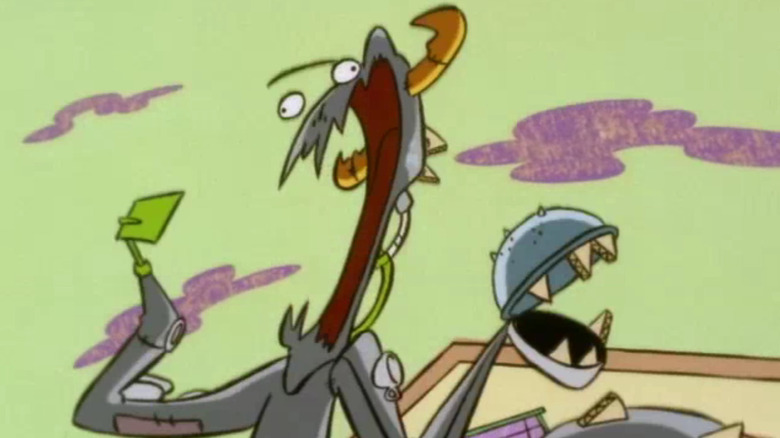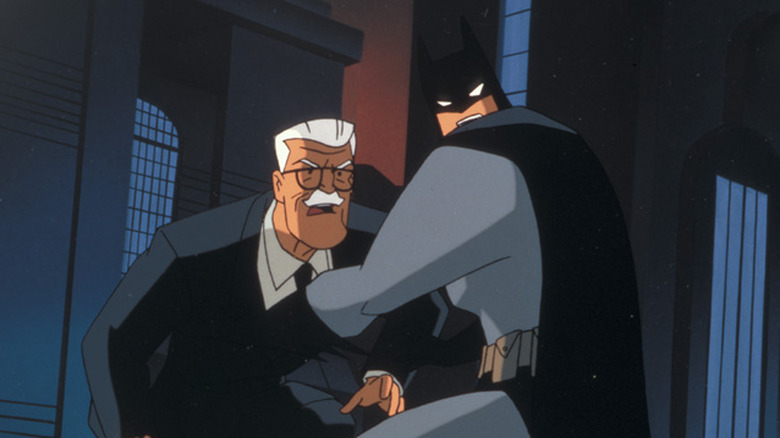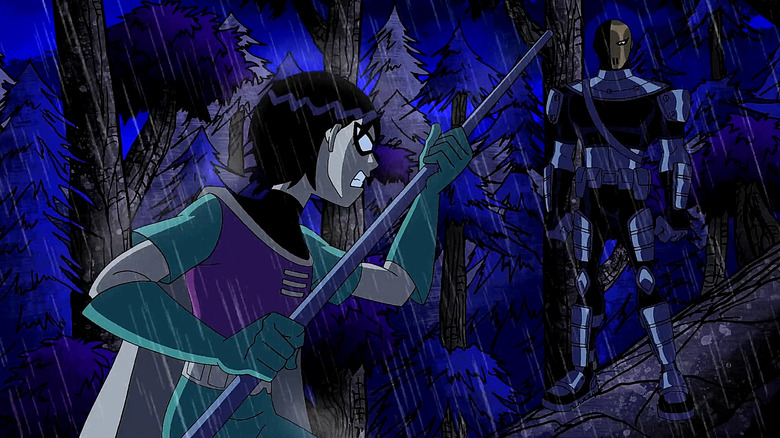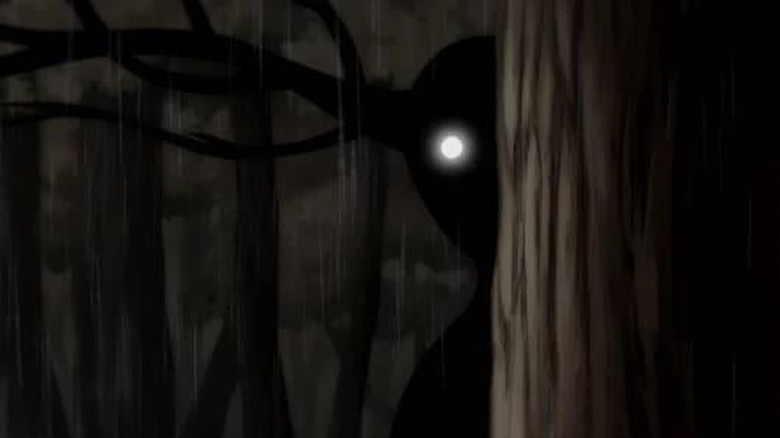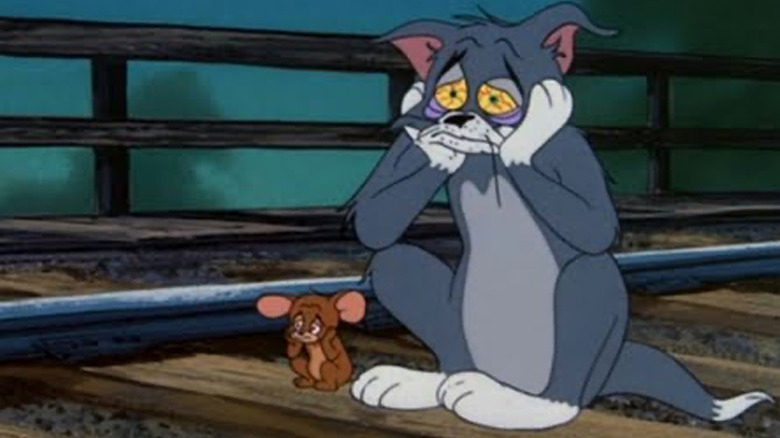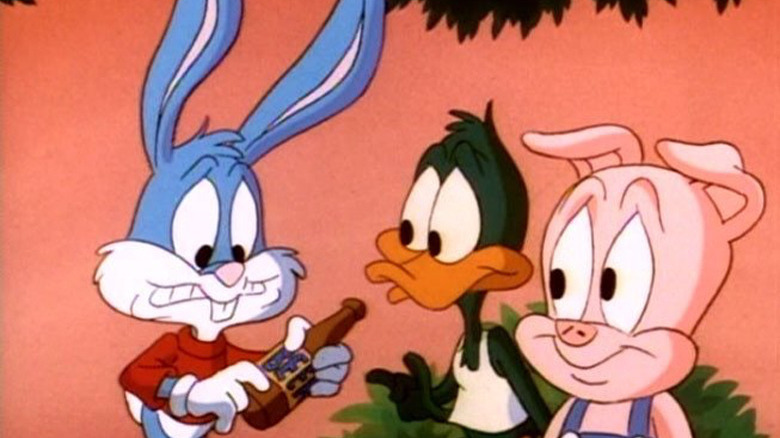Times Animated Shows Got Really Dark
Overall, the world of animation is an eclectic mishmash of styles and tones, and they aren't all for children. Limited only by the creators' imaginations, animated content can provide a slurry of mind-bending visuals and risqué writing. That said, shows generally geared toward little kids will take a dark turn every now and again. When this occurs, it gives the impression that the showrunners and writers have a respect for their audience and trust them to handle more unpleasant subjects.
These moments can range from the psychologically disturbing to the graphically violent. Plenty of all-time classic shows, including "Batman: The Animated Series," "Adventure Time," and "SpongeBob SquarePants" have drifted to the dark side, pushed a few boundaries, and achieved great acclaim in the process.
These are just a few noteworthy examples of animated shows with a younger demographic going really dark. Millennials might remember a few from their childhoods in the '90s. We've even included a cartoon old enough to have traumatized a baby boomer or two.
Squidward goes to purgatory
Few animated shows match the widespread appeal and success of "SpongeBob SquarePants." Since its debut in 1999, the show has become Nickelodeon's flagship franchise, spawning ample spinoffs and merchandise. The inaugural season takes an unexpectedly dark turn in the episode "SB-129."
As is par for the course, the episode begins with Squidward Q. Tentacles attempting to escape the constant annoyance of SpongeBob and Patrick. Squidward's efforts lead him into Krusty Krab's walk-in freezer, where Squidward is frozen for 2,000 years. Eventually, Squidward emerges in an all-chrome future where SpongeBob's cybertronic successors give him access to a time machine. After a bungled time-travel incident involving a prehistoric SpongeBob and Patrick, Squidward accidentally breaks the machine, leading to a malfunction that seemingly strands him in a white void.
At first, the notion of prolonged isolation appeals to Squidward ... until he begins to panic. After a period of searching, plus a tearful admission that he misses SpongeBob, he regains control of the time machine and returns home.
It's a classic episode, aided by a variety of unique settings, topped off with a disturbing yet hilarious depiction of a metaphor for purgatory.
Zim fills his body with other people's organs
If ever there was a cartoon that lives and dies by its own macabre individuality, that would most definitely be "Invader Zim."
The notion of Jhonen Vasquez, whose prior claim to fame was the hyper-violent indie comic "Johnny the Homicidal Maniac," creating a kids' cartoon seemed like a weird enough idea all by itself when "Invader Zim" premiered in 2001. Let's describe "Zim" as Hot Topic-style mall-goth version of "Tiny Toon Adventures," mixed with the nightmarish aesthetics of H.R. Giger — definitely a bit much for Nickelodeon's typical demographic.
One episode that gained the series some notoriety when it aired is "Dark Harvest," which is full of childhood trauma fuel.
The time comes for physical check-ups at school. While Zim has managed to appear human on a purely surface level, this is not the case for his obviously extraterrestrial innards. In a grotesque attempt to pass for Earthling on the inside, he harvests the organs of other students and stuffs them within himself. Zim becomes a sickening sack of pilfered organs, bursting to the point where intestines roll out of his mouth.
It's this absurd level of Cronenberg-style body horror that makes "Invader Zim" such a distinct and memorable series.
That freaky deer from Adventure Time
Over the course of its ten-season run, "Adventure Time" covers a ton of ground in terms of tone and visuals. The expansive Land of Ooo — home of the show's protagonists, Finn the Human and Jake the Dog — isn't afraid to get dark. Case in point: the Season 3 episode "No One Can Hear You" — a definite demonstration of the show's ability to terrify when it wants to do so.
During an incident with a rather invasive stag, Jake suffers a head injury, while Finn is knocked out cold. After awakening in the hospital with two broken legs, Finn surveys the Candy Kingdom, only to find it eerily abandoned.
He then discovers Jake digging through trash, inexplicably convinced that everyone is hiding to surprise him for his birthday. After realizing Jake has gone crazy, Finn also begins to understand that he's been in a coma for six months. Finn ventures into the sewer to discover Princess Bubblegum and the rest of the Candy Kingdom population stuck to the walls with melted sugar. This is all revealed to be the work of the stag — sometimes known as Freak Deer — who removes his hooves to expose a set of creepy fingers.
The whole episode plays like a colorful "28 Days Later," and is superbly uncomfortable.
That time the Powerpuff Girls' sister died
For as sugary sweet as "The Powerpuff Girls" looks, the show doesn't always steer clear of brutal violence and body horror. Creator Craig McCracken and his team infuse their various interests — including creepy comic book style creatures and Japanese Kaiju monsters — into the adventures of Blossom, Bubbles, and Buttercup. This helps give the show its unique identity, which managed to resonate with both boys and girls during its original run in the mid-'90s and early '00s.
The Season 2 episode "Twisted Sister" marks a particularly memorable instance of the generally bright and sunny series taking a hard turn towards the horrific.
The girls, burnt out from crime fighting and chores, sneak into the Professor's lab to create a new Powerpuff Girl to pick up the slack. However, due to their scientific inexperience, what emerges from the concoction is a gigantic and slightly misshapen Powerpuff Girl. The girls end up calling their new sister "Bunny," and show her how to fight crime in Townsville.
Unfortunately, Bunny is very bad at following instructions and begins freeing criminals from jail, resulting in total bedlam. Bunny eventually fixes her mistakes, but just as she saves the day, her unstable genetic composition begins to break down. Bunny explodes in a blast of white light with a pile of the ingredients remaining, much to the Girls' despair.
Courage the Cowardly Dog's anxiety nightmares
Any compilation of creepy cartoons worth its salt should include a reference to "Courage the Cowardly Dog." From alien chickens to freaky barbers, the turn of the millennium Cartoon Network fave is a buffet of mind-bending animated terror. Ironically, one of the most disturbing sequences of the show might just be one of the most relatable.
In the Season 4 episode "Perfect," Courage's human-antagonist Eustace grills the show's eponymous canine for his inability to handle certain household tasks. These comments impact Courage so much that he imagines a strict elderly schoolteacher who attempts to make him perfect. What follows consists of a series of increasingly bizarre and disturbing multi-media nightmares — a likely visual manifestation of Courage's anxiety. The images include a stop-motion version of Courage juggling plates, and a deranged blue CG creature who utters the words, "You're not perfect."
Eventually, a bathtub dwelling barracuda gives Courage a pep talk, explaining that there is no such thing as perfect. Following this revelation, Courage is able to move past his anxieties and embrace his imperfections. If you've ever suffered from anxiety or depression, then this episode could hit close to home for you.
Bloodbending in Avatar: The Last Airbender
"Avatar: The Last Airbender" is the perfect hybrid of mature writing, impeccable humor, and utterly gorgeous animation, which only improved throughout its original run in the mid-to-late '00s. A major example of the show's increasing intensity arrives in the Season 3 standout "The Puppetmaster."
While on their journey through the Fire Nation, Team Avatar encounters an old woman named Hama who owns an inn in a nearby village. Hama, voiced by American animation icon Tress MacNeille, soon reveals herself to be a former member of the Southern Water Tribe, like Sokka and Katara.
This leads to a fast friendship between Hama and Katara, the latter pleased to meet another waterbender. The two also bond over their shared trauma — Hama having been kidnapped by firebenders, and Katara having lost her mother to the same.
However, things turn sinister when the group look into a rash of disappearances in the village, all carried out at night. This coincides with Hama revealing she escaped her capture by inventing a new form of bending to control people — bloodbending. Soon enough, Hama has Aang and Sokka at her mercy, forcing Katara to reluctantly use bloodbending herself to stop Hama. The villain is defeated and carted off, but can only smile knowing that she has passed on her disturbing legacy to an unwilling student.
The Legend of Korra goes full-blown homicidal
A follow-up to "Avatar: The Last Airbender," "The Legend of Korra" had some big shoes to fill from its inception. Not only is "Avatar" a critical darling, its epic, multi-part finale wrapped the story up perfectly when it aired in 2008.
In 2012, a follow-up materialized in the form of "The Legend of Korra," set 70 years after the original show. The series follows Korra, the hot-headed successor of Avatar Aang.
In Season 1, Korra contends with Amon — the sinister leader of the anti-bending Equalist movement. She must also survive the machinations of Republic City Councilman Tarrlok, who is eventually outed as a bloodbender. Additionally, we discover that Amon, whose real name is Noatak, is Tarrlok's brother and shares his ability to bloodbend.
Once Amon is defeated at the hands of Korra, the two brothers appear to escape in a speedboat. Unfortunately for Noatak, Tarrlok opts to use an Equalist weapon to ignite the boat's engine and cause a fiery explosion. You don't usually see deaths of such a gruesome nature on a Nickelodeon animated series.
Creepy artificial intelligence in Gravity Falls
"Gravity Falls" is a show that dabbles in various subgenres of fantasy, science fiction, and horror. Young heroes Dipper and Mabel, plus their Grunkle Stan, run into the likes of candy monsters, menacing poltergeists, and all kinds of other frightening entities.
However, the episode we're interested in focuses on Soos, the Mystery Shack's lovable handyman. In 2014's "Soos and the Real Girl," the well-meaning doofus hits a wall in his search for a legitimate girlfriend. His luck appears to change when he finds a Japanese dating simulator in a bargain bin, and hits it off with the game's female sim, .GIFfany, portrayed by prolific voice actor Jessica DiCicco.
Soon enough, .GIFfany — a living artificial intelligence — becomes obsessed with Soos and aims to make him hers forever. This results in a sequence reminiscent of "Five Nights at Freddy's," in which .GIFany possesses a legion of play place mascots. It's a delightfully disturbing episode that shows the pitfalls of getting caught up in a fantasy world.
Ed turns into a legit monster
Anyone who's seen much "Ed, Edd n Eddy" might guess that creator Danny Antonucci has a great appreciation for the horror genre. This affinity for monster movies becomes obvious through the character of Ed, who is obsessed with science fiction and old splatter flicks.
Ed's fixation takes center stage in the Season 3 episode "The Day the Ed Stood Still." The Eds plan to scam the other Cul-De-Sac neighborhood kids with a fake carnival, but all goes to hell when Ed begins acting up. Eddy attempts to capitalize on Ed's apparent desire to be a monster by crafting him a costume. Unfortunately, Ed immediately goes berserk and begins a legitimate rampage across the Cul-De-Sac, much to everyone's horror.
Much like many other "Ed, Edd n Eddy" episodes, this outing is a solid pile of visual gags. However, "The Day the Ed Stood Still" also boasts some legitimate terror, when Monster Ed slowly takes each of the kids one by one and sticks them to walls, in a fashion very similar to the deleted cocoon sequence from the original "Alien."
Batgirl dies in her dad's arms
"Batman: The Animated Series" is regarded as one of the best interpretations of the Caped Crusader ever put on screen. The show is a gem, defined by its angular design style, gorgeous noir imagery, and incomparable voice acting.
It also gets unapologetically dark on a much more routine basis than the other programs listed here. "Batman: TAS" ends plenty of episodes with deaths or somber moments. However, the 1998 episode "Over the Edge" takes the show's usual darkness to a whole new level.
While pursing the Scarecrow on the roof of Gotham City Hall, Batgirl, aka Barbara Gordon, falls off the building after the fear-obsessed villain gets the drop on her. Batgirl crashes onto a police car, which just so happens to be driven by Commissioner Jim Gordon, her father. Commissioner Gordon removes her mask and discovers the truth after she calls him, "Dad."
While this moment is later revealed to be part of a fear gas-induced dream Barbara experiences, it doesn't lessen the impact. This moment serves as a great example of just how mature the minds behind "Batman: The Animated Series" were willing to get ... as long as they could eventually say it was all just a dream.
Robin hallucinates his dead arch enemy
The mid-'00s Teen Titans series, much like its comic book counterparts, certainly cranks up the darkness every so often. Nowhere is that better exemplified than in the Season 3 outing "Haunted," one of the most intense "Teen Titans" episodes.
In "Haunted," Robin is still struggling to accept that Slade is really dead following the events of Season 2's (literally) fiery finale. Following a late night look at his foe's dusty remnants, Robin and the team are called into action. Things take a turn when Slade begins appearing to Robin, while the other Teen Titans can't see him. Bit by bit, Robin begins to lose his marbles and lash out on his team, making them question their leader's sanity.
Visions of Slade continue to torment Robin, causing him more mental anguish and some legit physical harm. The true highlight of the episode is Scott Menville's voice work, which sells Robin's paranoia and increasing exhaustion. Ron Perlman, best known as the star of 2004's "Hellboy," cranks up his sinister delivery as Slade, serving as the specter who taunts Robin from the darkness. The sight of the usually chipper Boy Wonder slowly losing his mind is genuinely disturbing.
The Beast from Over the Garden Wall
"Over the Garden Wall" is one of the more visually and thematically dynamic projects Cartoon Network ever aired, which is saying something, considering that station's reputation for taking risks on unconventional projects.
The miniseries follows Wirt and Greg, two brothers who, appropriately enough, go over the titular garden wall and find themselves in a different era. They venture through a mysterious forest and encounter all sorts of curious inhuman threats and allies.
One such threat is known only as the Beast — a horned creature who stays in the shadows. In the series finale, Greg opts to save Wirt by willingly giving himself over to the Beast. This means Greg is volunteering to be worn down, and eventually turned into a tree. If these circumstances weren't already nightmarish enough, the terror is heightened when we glimpse the Beast's true form. His seemingly wooden body appears to be composed of the petrified faces of his many victims.
It's a "blink and you'll miss it"-type moment, but one that roundhouse kicks your brain with a genuinely horrific visual.
Tom & Jerry sat on train tracks
Dating all the way back to 1940, "Tom & Jerry" stands as one of the best examples of how to convey brutally painful slapstick in animation. If an animated show entails two characters constantly walloping each other with heavy objects, chances are it's influenced by "Tom & Jerry." However, the legendary cat and mouse duo go too far every now and again; for instance, a 1956 episode in which they apparently attempt to take their own lives.
"Blue Cat Blues" opens with a depressed Tom sitting on the tracks, waiting for the train. Jerry, serving as the narrator, flashes us back to what preceded this situation. In the flash back, Tom encounters an attractive female cat. Immediately smitten, he dedicates every aspect of his life to pleasing her, even though she is clearly manipulating him. She immediately and predictably leaves Tom when a richer cat comes around, leaving Tom a broken cat.
Jerry laments Tom's situation, and expresses gratitude for his stable relationship with his girlfriend ... who promptly rides off with another mouse. This leads to Jerry, now equally broken, to approach Tom and ask him to make some room on the rails.
If you or someone you know is struggling or in crisis, help is available. Call or text 988 or chat 988lifeline.org
The Tiny Toons get drunk and die
"Tiny Toon Adventures" is a show filled to the brim with writing and voice acting talent. Serving as the predecessor for the more enduring "Animaniacs" in the early '90s, "Tiny Toons" offers an eclectic variety show consisting of younger versions of Looney Tunes characters. Instead of Bugs Bunny, we were treated to a boy and girl duo named Buster and Babs Bunny (no relation). The show is remembered fondly by many, making the existence of its banned episode – "One Beer" — all the more bizarre.
In a disturbing doozy of a Saturday morning alcohol PSA, Buster, Plucky Duck, and Hampton J. Pig find a beer in the fridge. Buster, ever the instigator, insists that they drink it. What results is an all-night bender in which the once innocent trio devolve into scraggly winos. Their boozy escapades conclude when, while driving under the influence, they crash their car and ascend to heaven. After their apparent demises, our heroes break the fourth wall and say they hope the kids watching at home got the message.
If you or anyone you know is struggling with addiction issues, help is available. Visit the Substance Abuse and Mental Health Services Administration website or contact SAMHSA's National Helpline at 1-800-662-HELP (4357).
